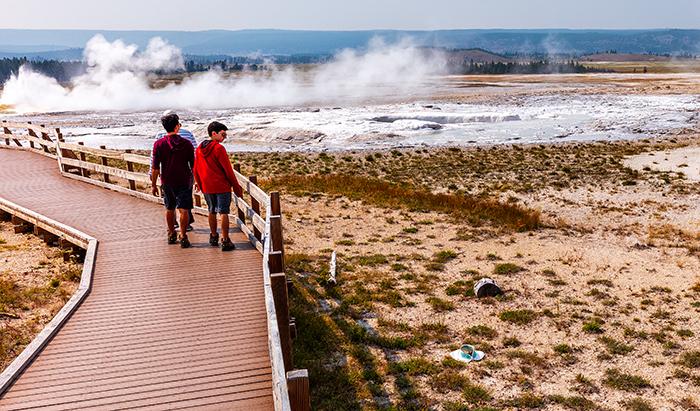
Looking at something along the nature trail other than the geysers, Yellowstone National Park / Rebecca Latson
I recently completed a three-week road trip and move from southeast Texas up to central Washington State. All by my lonesome, in my little, loaded down, Honda Fit (ok, with the help of a moving company to transfer the big stuff later on). En route to Yakima, I visited and photographed five national parks: Petrified Forest National Park, the North Rim of Grand Canyon National Park, Bryce Canyon National Park, Grand Teton National Park, and Yellowstone National Park.
During that time, I saw plenty of things resulting from poor planning or simply not thinking on the part of the park visitor. Some things I saw made me roll my eyes, while other things really torqued my jaw (metaphorically). Thus, I felt the need to write about what I saw and to give visitors a little bit of advice on how not to be stupid. I’m pretty sure I’m going to irritate some of you. Nobody likes to be reminded of dumb things they do. At the same time, I’m sure there are many of you out there who will agree with me. I can’t please everybody with my articles. Note: These observations are my own and thus may not be the opinion of the Traveler.
1) Footwear
There are many locations within national parks where a wonderful job has been done of creating and maintaining trails suitable for everybody, including people in walkers and wheelchairs. As I write this, I’m thinking of the boardwalks and paved paths in the Upper Geyser Basin of Yellowstone National Park. Kudos to the NPS for producing these accessible routes to stunning venues. Even people wearing flimsy sandals and jogging shoes can maneuver around without too much issue.
However … there are other trails where people really need to think about their footwear choice.
I’m sure you, yourself, have noticed this. Most of the tour buses disgorging their human cargo don’t apparently delve much into detail regarding the type of shoes their passengers might need to consider when visiting a place far away from metropolitan infrastructure. Having watched the tour buses along the South Rim of Grand Canyon National Park, I know that most of those organized tours aren’t going to do more than allow for a 20-minute stop before heading on to the next sight.
Nonetheless, I can’t tell you how many people (primarily from those tours) I saw wearing Keds-type no-traction tennis shoes on the trail. Yes, I will own up to the fact that most of those particular trails are either paved or really well-maintained, but, at one point while hiking the Fairyland Loop Trail toward Tower Bridge in Bryce Canyon National Park, I saw a line of ladies holding their little umbrellas against the sun, inching carefully down a steep portion of the unpaved trail wearing nothing but no-tread trainers guaranteed to twist an ankle at some point in time.

It can get a little steep on the Fairyland Loop Trail, Bryce Canyon National Park / Rebecca Latson
Here’s another example. If you’ve ever been to the North Rim of Grand Canyon National Park, you’ll know of two small overlooks below the Grand Canyon Lodge. The trail to reach either view is unpaved and uneven in places. You must then take a short series of very uneven steps down to a short paved path to the fenced-in views, where the ground of the view area is rocky and uneven to the point that even I, in my hiking boots, must watch my step so as not to stumble.

Quite a view at the North Rim, Grand Canyon National Park / Rebecca Latson
All of this is a preamble to the day I stood at one of those view areas to capture a sunrise shot. I’d set up my tripod and had my eye to the viewfinder. I heard this slow, measured “flip flip” behind me. Turning, I saw a young man wearing flip flops, slowly and carefully wending his way to where I stood. Talk about the surest way to twist an ankle.
Here’s the deal with flip flops: They have no tread, you have to keep squeezing your toes to keep them on, they have no foot or ankle support on uneven ground (even uneven paved ground), and if you lose one of them down a steep precipice or while standing in a river or the sea (and they are easy to lose), you’ve effectively littered in the park. Ditch the flip flops on a trail, people. Get some hiking shoes or boots. You are not in the city.
2.) Perfume and Aftershave
When I am out in a national park, I revel in the fragrance of fresh air filled with cedar, fir, pine or sage. My nose thanks me for those sumptuous scents. And then, I pass a woman wearing perfume or a man wearing strong aftershave. These are the people who not only invade my fresh air space, but also can’t smell anything other than their Chanel #5 or Old Spice. In case you are wondering, does self-administered fragrance affect the wildlife? A quick Google search pulled up nothing of note, but perfume and aftershave certainly affect *this* writer. Leave the perfume and aftershave for your office or an evening out.
3.) Hats
We all wear hats when visiting a national park. That sun (or rain) beats down on us and we need protection. We need a hat to keep the wind from blowing our tresses into our face; nothing worse than a mouthful of hair, believe me. I wear a hat every time I am out with my camera. But, you need to remember to affix that hat FIRMLY to your head. National parks get windy – really windy – and if you don’t have your hat tied down, it will blow off and litter the park.
The following images show you the number of hats spoiling portions of hot springs and bacterial mats in Yellowstone National Park. All that natural beauty marred by a clothing item that the wearer should have taken time (and a little thought) to tie down firmly to their head before touring the sights.

A hat in the bacterial mat, Yellowstone National Park / Rebecca Latson
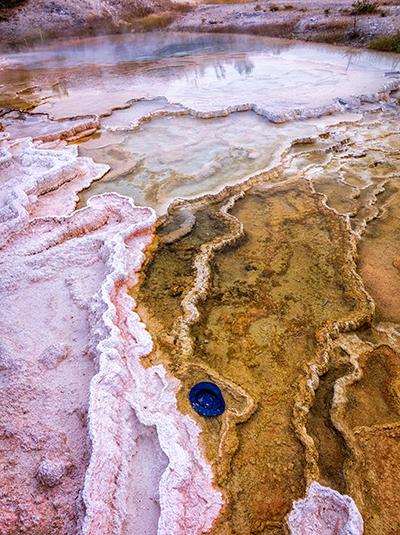
A hat at Mammoth Hot Springs, Yellowstone National Park / Rebecca Latson

A hat near Canary Spring, Yellowstone National Park / Rebecca Latson
4.) Drive the Damned Speed Limit
The national parks I visited all had a maximum speed limit of 45mph (72 kph), and sometimes, 25mph – 35mph. They do that for a reason. You know, it’s kinda nice to drive that 45mph and admire all the beautiful scenery for which a national park is famous, but a slower speed limit is also for your safety and wildlife safety. I can’t tell you how many times a chipmunk, bunny, or deer (and even a bear, once) crossed the road in front of me. Had I been driving beyond the posted speed limit, that wildlife and my vehicle would have both been toast. I invariably saw people (usually with California license plates), pass me on the narrow road because I was going the posted speed limit and they wanted to apparently drive 65 mph or whatever speed limit du jour of the state in which they reside.
If you want to drive fast, don’t do it in a national park. Rent some time on a speedway, instead, and get it out of your system.
5.) Parking
In each of the parks I visited, there are signs all along the roads prohibiting parking in anything other than the designated parking spaces, pullouts, or specific widened road shoulders. Yet, I saw it time and time again – parking anywhere people could pull over after all the legal spaces were taken up. There are a lot of drivers unfamiliar with the route, or just plain poor drivers to begin with. As drivers park their cars or RVs on both sides of the narrow roads, then walk down the roads to the site, they don’t make it any safe for other drivers or walkers. Unfortunately, there are currently not enough rangers out there to enforce the rules. It’s encumbent upon you, the driver, to slow down to 15 mph when passing heavily-congested areas and to PLEASE park only in designated areas.

Nowhere to park at Grand Prismatic, Yellowstone National Park / Rebecca Latson
6.) Litter
There are signs all over the place to not litter. And yet, people still do it. I remember sitting on one of those benches curving around Old Faithful near the Old Faithful Lodge and discovering an empty yogurt cup and plastic spoon underneath my seat. The trash bin was just a few steps away. And yet, the eater of the yogurt was too lazy to get up, walk over, and place the cup in the trash. A robust wind might have blown that empty container off the boardwalk and onto ground beyond the boardwalk where visitors are prohibited from walking. I saw empty cups, cellophane wrappings, and paper receipts marring the bacterial mats and thermal pools. I will grant that perhaps the wind blew some un-secured trash item, but that’s even more reason to THINK and SECURELY stash your trash.

A paper cup off the boardwalk at Upper Geyser Basin, Yellowstone National Park / Rebecca Latson
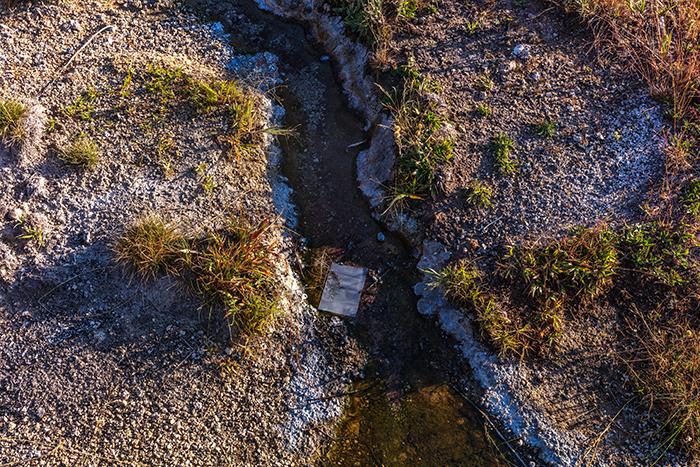
Paper receipt in a runoff stream, Upper Geyser Basin, Yellowstone National Park / Rebecca Latson
Oh, and one other thing. Just because your orange peels or banana skins are compostable, that doesn’t mean it’s OK to simply throw them to the side once you are done eating In a June 19, 2018 online article, Glacier National Park officials warned that while we think of fruit peels as biodegradeable, it really takes them a long time to biodegrade (I believe their word is “rot”) and it’s dangerous for the wildlife. Litter is litter, folks. Pack out what you pack in. It’s really not that difficult to bring along a little bag in which to put your used Kleenex, food peels, etc. and then put that little bag in your purse, backpack, or photographer vest pocket.
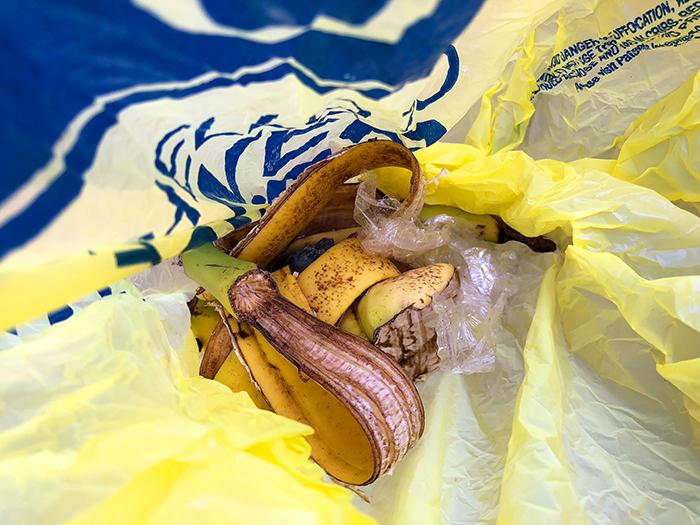
Litter the photographer picked up at Yellowstone National Park / Rebecca Latson
I’ll bet you readers have seen some pretty stupid stuff out in the national parks (including people harassing the wildlife … and later getting arrested for it). I’d be interested to know what you’ve witnessed, and I’m sure the Traveler would, too. If you’ve experienced up close and personal the lack of planning, laziness, or unthinking stuff people have done, put that in your commentary below this article. Regardless of the fact that people don’t like to be reminded of their – er – transgressions, I’m hoping they do a better job of remembering those actions the next time they are out enjoying a national park.

Please, don't feed the wildlife, Glacier National Park / Rebecca Latson

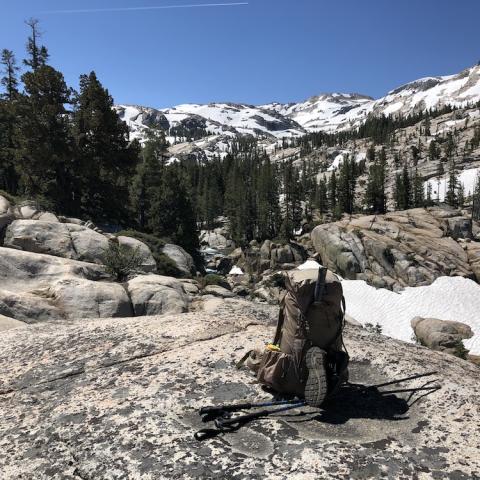

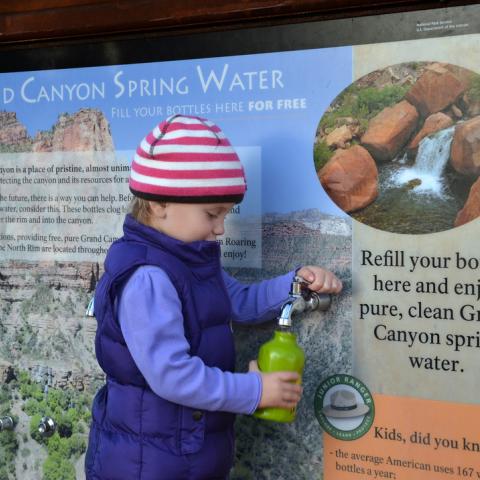
 Support Essential Coverage of Essential Places
Support Essential Coverage of Essential Places







Comments
We were at Sequoia National Park this spring and encountered many, MANY people taking the Sugar Pine cones. We stopped all of them that we saw to tell them that taking items from a National Park is illegal and is considered theft. Every single person we spoke to acted likle they had no idea that removing such items is illegal (even though there are signs posted throughout). A few people put them down and walked away but others just scowled and kept walking.
Waddlers - a great new term for an observable species.
I agree with all your points and have seen each of them many times in many parks. Perhaps taking photos while you're supposed to be driving isn't such a good idea, either.
It is the litter that offends me the most, not only in parks, but even in cities. How difficult is it to carry the almost weightless litter to a proper disposal container? Litter is ugly and if everyone littered, the parks would be most unattractive and few would want to visit them. Certainly many metropolitan areas that are popular with tourist and city dwellers are becoming more littered and/or covered with graffiti. This problem seems to be getting worse, which seems indicative of a decline in respect for public and private property in society everywhere, especially among city dwellers.
I have always been amazed at hikers, even on a long trail in Rocky Mountain NP, wearing flipflops. I'm always getting rocks kicked up into my boots even, so I know rocks must get between the feet and the flipflops of those hikers. Stubbing a toe is even a hazard, when wearing proper footwear, that must be even more true for those wearing flipflops. Or maybe we are just wimps and those flipflop wearing trail walkers are really tough!
I propose that the park system require visitors to take a training course prior to visiting the parks and to demonstrate a mastery of the rules, regulations, safety issues, etc. before being permitted into a park. Proof of completing such a course and passing a test would have to be presented at the entrance. Such a requirement might even reduce the crowds in the parks, allowing those who really appreciate nature to enjoy the parks without the entrusion of the casual, disrespectful visitors.
My wife and I have been visiting National Parks every year for forty years and believe me we have seen everything. Although these parks belong to all of us I think you should have to pass a test prior to entering any of them.
I would also like to point out all the people who go off the trails when there are signs all over the place the say "Stay on the Trail". This stupidity kills plants that have been growing for hundreds of years. People only think of themselves and not the consquences of their actions. Always be respectful of rules and regulations in our National Parks as we all are stuards of these precious places and would like future generations to be able to enjoy as we have.
I have seen all of those things you mentioned plus some, just recently on a trip to Yellowstone! So frustrating when people tend to ignore all rules in our beautiful national parks. I have seen many people doing 5 mile hikes on rough terrain in the Smoky Mountains wearing only flip flops! Really?? I think if people are caught doing things they shouldn't be doing they should be required to take some classes on how to behave in our national parks, so they are preserved for future generations!
Thats story about the chipmunk soounds similar to what I experienced in Yellowstone. A girl was feeding one & I said to her you can't feed the wildlife & then the dad jumps in & says yes its fine. I said no its illegal & that I would report them to NPS & the dad said it's just a chipmunk & I said it doesn't matter feeding ANY wildlife is illegal. If I see someone doing something wrong I will say something to them or tell a park ranger if one is nearby. People who don't respect our national parks frustrate me!